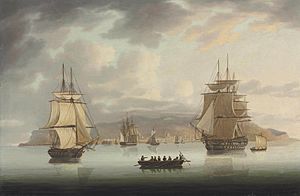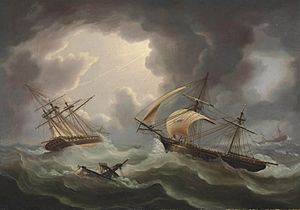HMS Harrier (1804) facts for kids
Quick facts for kids History |
|
|---|---|
| Name | HMS Harrier |
| Ordered | 23 May 1804 |
| Builder | (Mrs.) Francis Barnard & Sons, Deptford |
| Laid down | June 1804 |
| Launched | 22 August 1804 |
| Fate | Lost, presumed foundered March 1809 |
| General characteristics | |
| Type | Cruizer-class brig-sloop |
| Tonnage | 383 32⁄94 (bm) |
| Length |
|
| Beam | 30 ft 6+1⁄2 in (9.3 m) |
| Depth of hold | 12 ft 9 in (3.9 m) |
| Sail plan | Brig |
| Complement | 121 |
| Armament |
|
HMS Harrier was a type of fast sailing ship called a Cruizer-class brig-sloop. She was built in 1804 and was part of the British Royal Navy. Harrier was involved in many important battles and events before she sadly disappeared in March 1809. It's believed she sank at sea.
Contents
Life at Sea: Harrier's Adventures
The HMS Harrier officially joined the Royal Navy in November 1804. Her first commander was William Woodridge. He sailed her to the East Indies (which is now Southeast Asia) on December 24, 1804. In 1805, Commander Edward Ratsey took over as her captain.

Facing the French Sémillante
On August 2, 1805, Harrier had a fight with the French frigate Sémillante. This happened in the San Bernardino Strait near San Jacinto, Philippines. Harrier was joined by another British ship, Phaeton.
The two British ships exchanged fire with Sémillante. The French ship then moved to a safer spot under the protection of shore cannons. Since they couldn't get to her, Harrier and Phaeton eventually sailed away. Each British ship had two sailors wounded. The French ship, Sémillante, reported 13 sailors killed and 36 wounded.
The Sémillante had planned to sail to Mexico to pick up money for the Philippines. But this battle stopped her plans. Instead, she returned to the Indian Ocean and spent the next three years attacking British ships from Île de France.
Capturing Dutch Ships
In 1806, Lieutenant Edward Troubridge became the commander of Harrier. On July 4, Harrier was sailing with Greyhound. Together, they found and destroyed a Dutch ship called Christian Elizabeth. This ship was a brig (a type of sailing ship) with eight guns and 80 crew members. She was hiding near Fort Manado.
Greyhound and Harrier then sailed to the island of Tidon in the Celebes (now part of Indonesia). There, on July 6, they captured another enemy ship, Belgica. This ship had 12 guns and 32 crew members.
The two British ships continued sailing west. On the evening of July 25, they spotted four ships in the Salayer Strait. The next morning, they were ready to fight the Dutch ships.
The Battle of July 26, 1806
After about 40 minutes of fighting, the Dutch frigate Pallas surrendered to Greyhound. Harrier fought against two merchant ships, Victoria and Batavier, and they also surrendered to her. The fourth Dutch ship, a corvette named William, managed to escape.
The Dutch ship Pallas had many casualties, with eight sailors killed and 32 wounded. Six of the wounded later died, including the Dutch captain. The two captured merchant ships had four sailors killed and seven wounded. One of the wounded later died.
The British ships had much fewer losses. Greyhound had one sailor killed and eight wounded. Harrier only had three sailors wounded.
On board the Pallas was Mr. Robson, the chief mate of Sydney. His ship had wrecked off New Guinea earlier. Robson and some other sailors had reached Ambonya, where the governor had treated them kindly. He then put them on the Pallas.
The three captured Dutch ships were taken to Port Cornwallis on South Andaman Island. Commander Troubridge was promoted in September and took command of HMS Celebes, which was the captured Pallas. Commander William Wilbrahim then became the new captain of Harrier.
Surviving a Hurricane
Between February 1 and 3, 1807, Harrier went through a terrible hurricane near Madagascar. She was on her way to the Cape of Good Hope (at the southern tip of Africa). During the storm, Harrier saw Blenheim and Java. Sadly, these two ships were never seen again after the hurricane.
Blenheim was the main ship of Admiral Sir Thomas Troubridge, who was Edward Troubridge's father. One of the passengers on Blenheim was Elphinstone, who had been called back to Britain. Harrier managed to reach the Cape of Good Hope, but it was a very difficult journey. She had to be repaired there.
More Captures
In 1807, Commander George Pigot took over command of Harrier. He was later replaced by Commander Justice Finley (acting captain) at the Cape of Good Hope. Finley was the captain of Harrier on August 7, 1807, when she captured a ship called Helena.
Harrier, Laurel, and Grampus worked together to capture the ship Jeune Laure on March 5, 1808.
Commander John James Ridge was the captain of Harrier on October 19, 1808, when she captured the French ship Soeuffleur. Harrier, Nereide, and Leopard also shared in the capture of the ship Goende Monche on January 5, 1809.
The Final Voyage
On March 13 and 14, 1809, Harrier was sailing with her sister ship Racehorse. They were about 1,000 nautical miles (about 1,850 kilometers) from Rodrigues island. Harrier fell behind and was never seen again. It is believed that she sank with everyone on board.
See also
- List of people who disappeared mysteriously at sea


